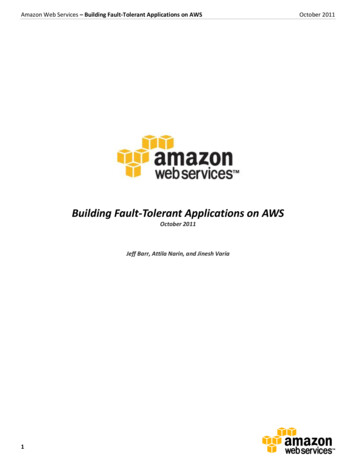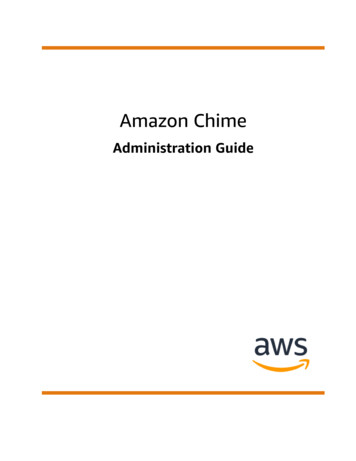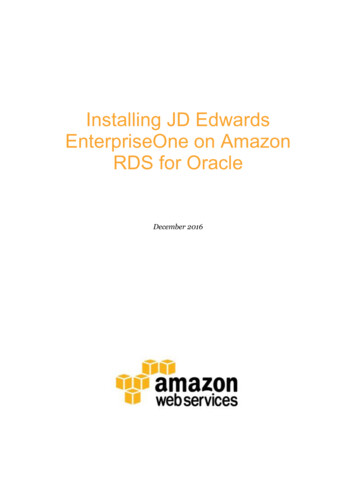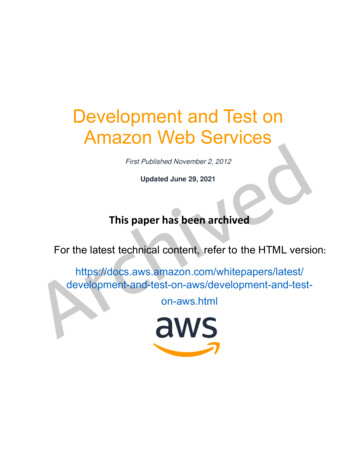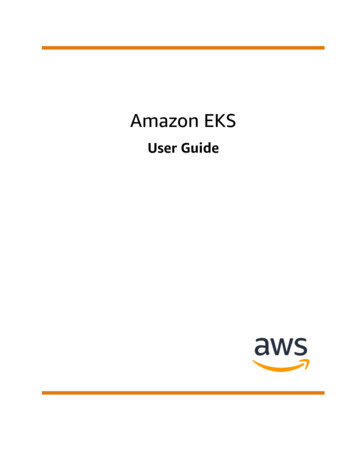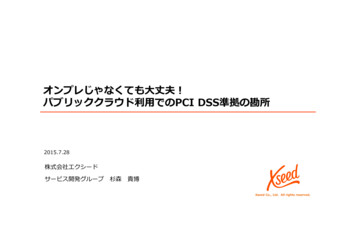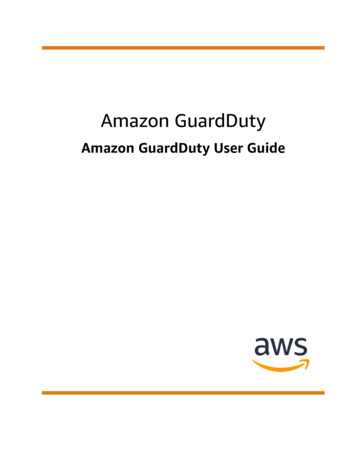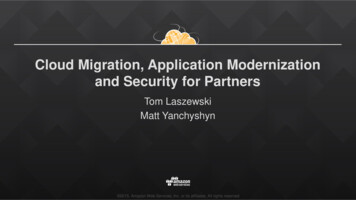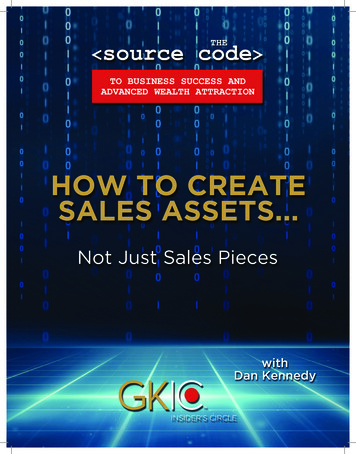
Transcription
REPRINTED FROMDAN S. KENNEDY’S No B.S. Information Marketing LetterDECEMBER, 2013Each Special Report brings you an extended length dissertation on one aspect of infomarketing. These Reports alternate every other month with Issues of The No B.S.INFO-Marketing Letter*; 6 times a year, a new Report, 6 times a year, the newsletter.The Letter/Reports are included in Information Marketing Association Membership as aMember Benefit (www.info-marketing.org).*NOT to be confused with the regular No B.S. Marketing Letter or The No B.S. Marketing To The AffluentLetter also published by GKIC.) ****************************************The Information Marketing Association provides Insider Secrets, Access to Experts and Step-by-StepResources Assembled for Creating and Running Simple and Easy Multimillion-Dollar InformationMarketing BusinessesSuccessful authors, self-publishers of books, people who sell home study courses, personal andbusiness coaches, newsletter publishers, and seminar promoters turn to the Information MarketingAssociation for the critical insights on the business side of running a successful information marketingbusiness. This information gap can only be filled by the one and only trade association for theinformation marketing industry.The IMA offers everything you need to continue to grow your information marketing business underone umbrella. The benefits are too many to list.Because you have this report, you can experience all of the benefits for free, for 2-months, with aninvitation only opportunity to get a two month trial membership. Just visit www.IMAFree.com to takeadvantage of this opportunity, while it *************************************1
This Report is really more of a rant. A contemplation. An airing of aconversation I have repeatedly with several clients. All in one. There areno exhibits or examples, just a summary of my thinking – and advice toclients – on the subject. I hope you find it provocative.As you must know by now, we celebrated my 40th Anniversary ininfo-marketing at the GKIC Info-Summit, so I thought talking about “old”seemed especially appropriate. We are also in auld lang syne season, a timeof reflection on our individual and collective past.There is a lot of pressure to be “brand new” all the time. If Apple doesnot have a radical, groundbreaking new innovation every 3 months, WallStreeters and financial pundits worry that its CEO, Tim Cook, has “lost it”and needs replaced. This “now, this minute” thinking infects almost everyindustry and field, to its detriment. I believe it is over-wrought. And thatpaths to profit often ignore it. So, my take on .When Is Old New Again?In the December issue of the No B.S. Marketing to the Affluent Letter, Ireferred to the Christmas season TV commercial campaign Lexus runs – they reused the same commercials for the 3rd year in a row in 2013. I say: good for them.When I first started out as a “motivational speaker”, the wise old owl,Cavett Robert, persuaded me to use the “there must be a pony in heresomewhere” joke, which, to my mouth, tasted much like the stuff the pony wasbeing found in. He – CORRECTLY – said, “It’s new TO THEM.” A client used todrag me in every month, for about 5 years, to talk about replacing his tired, oldTV infomercial with a new one because “everybody’s seen it” – despite steadysales numbers. To my credit, that should be good for credit in heaven, I kepttalking him out of pouring his money into a new show. That show still, to thisday, holds the all-time record for uninterrupted airing, for a pure lead generationshow: 8 years. Every night, it was brand spankin’ new to enough people.There are four big mistakes info-marketers makeabout “old stuff”Mistake #1: personal disinterest in what I call “the gold in the old”. Frankly, it’ssinful and criminally stupid for ANYBODY in this group not to have leapt at theopportunity to own my new Lifetime of Work Archives Collection*. To their credit,Frank Kern and Scott Manning, both very experienced yet relatively youngmarketers raced to be first to buy, at the Info-Summit. For anybody in healthcategories not to leap at the Making Them Believe/Dr. Brinkley Home Study Courseand Archive*, dumb, dumb, dumb. For anybody using a newsletter(s) as “glue”2
not to study the Jerry Buchanan material I assembled, that I originally studied,foolish.** I’m currently writing a lot of opportunity copy for a major client, and Iwent through my 1900 to 1970 swipe file of opportunity ads and sales letters tofind re-cyclable ideas. My Titanium Member Nelson Searcy, to his credit, puts amini-bio and “lessons of” piece about a long ago elder of Christian ministry infront of the pastors and church leaders he coaches every month via hisnewsletter. More info-marketers need to do this. Just as we NEED to get our folksto read and have Study Ethic, we NEED to get them interested in the history oftheir field – both interests make them better customers.*Information about this amazing, comprehensive, example rich Collection even complete with full replicas of key marketingpieces, audio recordings, and video, should be enclosed. If not, contact GKIC. The Brinkley Course is also available from GKIC.**The Jerry Buchanan Archive is available from Pete Lillo’s office, 330-922-9833.Mistake #2: getting tired of speaking about and writing about and teachingwhat “THEY” most need to hear and/or what has been your stock ‘n trade, whatbrung you to the dance, what got you in the game, just as dumb as the agingsinger or comedian refusing to do the songs or bits he’s known and beloved for.Paul McCartney once tried refusing to play Beatles music at a concert. In ourworld, people like my friend Robert Ringer – who long ago became unwilling tospeak about ‘winning through intimidation’ – do themselves enormousmarketplace harm. Zig wisely pumped the pump and told the Biscuits, Fleas ‘nPump-handles story all the way to the last speech.On the November Diamond Call, Ben Glass clearly, concisely stated thefive things he wanted the lawyers he sells to and coaches to know about him, his‘core story’, and he tells it consistently, frequently, ad nauseum to make surethey get it and its point. There has to be this ‘foundation’. You will think they allknow it. You’re wrong. You will think they’re sick of hearing it. Wrong. Irecently got a note from a 15 year Member, who felt he had to tell me how he’dbeen encouraged by my ‘cat who licked stamps story.’ Has he heard or read ittoo often? Or despite it appearing in a number of places in print and being toldby me repeatedly, did he only notice it once, when it meant something to him?One of the things you learn by reading a lot of detective-series fiction,where the same lead character and a few supporting cast members, reappear inbook after book after book, thrust into different situations but approaching themwith the same modus operandi, is that readers do NOT want those characters tochange. We don’t want Nero Wolfe to suddenly become bored with stayinghome, with his orchids, with his reading, drop 100 pounds and take up skateboarding. In Win, Place or Die, the novel I wrote with Les Roberts, I took hischaracters to a new place (the racetrack) but within their constant place(Cleveland), and he kept his characters consistent. If a writer like Les gets boredwith his characters and starts separating them from their foundation-ofconsistency, he’ll get in trouble, fast. The foundation has to be put in place3
redundantly in every book to educate the new reader and it has to be there in afamiliar way for the long-time fan.One way to “lock in” a lot of this is in material, online presentations, or,best, ‘live’ new customer-member training classes exclusively for those new toyour tribe. GKIC is doing this well, with its Fast Start Implementation BootCamps. These can be delivered exactly the same, literally forever, and should be.However, you can’t think “okay, we TOLD them”, and that’s done. You hearyourself say it every time you say it. I’ve heard myself say things 10,000 times.But the individual is hearing it now, once.Incidentally, we used to get better indoctrination by pushing and gettingcompliance with “spaced repetition learning” – getting them to listen to the sameinstructional recordings 7 to 21 times. I used to push “sleep learning”: listeningrepetitively every night with a pillow-speaker, so material could be imbedded inthe subconscious while the conscious mind’s sentry dozed. This is pretty muchall in the past. Depending on what you “told” them, sticking, being recalled andinfluencing days, weeks and months later is a losing proposition with no basis.How To Pee Away A Lot Of MoneyMistake #3: one ‘n done or short term promotion-driven marketing (like:launches, or infomercials, or solo mailings, or pitches at events) then relegatingboth the successful product and its marketing to a box in the corner of thebasement. Amongst other things, this ignores Ogilvy’s principle of “the movingparade of interest.” (If you haven’t STUDIED Ogilvy, and you claim to beengaged in advertising as a professional, refer to Mistake #1.)I tell my copywriting clients: I’m too expensive to pay just to sell some stuff.Let’s create assets for you. I teach copywriters to work at getting their clients tothink this way. It isn’t easy. I have a client who paid me 25,000.00 to write a fullpage ad for him, now, 8 years ago. It runs every month in the same fewmagazines. Is it old? Obviously. Do a lot of the same people read thesemagazines month after month? Yes and no. Yes – but few people are exactly thesame people month to month, year to year. Each individual changes. There isalso some circulation turnover – people who lose interest and leave; new peoplewho arrive. Combined, there are enough people the ad is new to every month. Inhis case, 25,000 divided by 3 magazines and 96 months; 288 a “Dan cost” of 86.00 per run of the ad, dropping each month. That’s an asset, bought at abargain price. How would you like to get to hire me to write a full page ad foryou, for eighty-six dollars?This involves many success factors beyond the copy, like Place Strategy; acomprehensive system for monetizing leads; and more. But this is the worthiest4
aspiration: a stable of consistently performing assets with long life, so yourinvestment in them amortizes down to near zero.I was recently retained to write copy for an info-marketer to fill “freepreview seminars” all across the country, for a year’s tour. I wrote it to do that,but also fill regional, paid seminars, and also to drive prospects from areas no liveseminar will come to into an online funnel, and an online video sales event, andalso to generate leads to be sold by sending material and driving to a tele-shark.One of these uses has the potential to be evergreen and automated.One time use promotions and, less so, products are sometimes necessary orthe best of options. But operating entirely based on your next “blockbuster hit” isa great way to pee away a lot of money. It is like buying or building a greathouse and furnishing it expensively, to live in for 4 months, then burning itdown and walking away. Sure, you had a great 4 months. But.Why Bob Iger at DisneyPaid George Lucas ALL That MoneyTo Own ‘Star Wars’At bare minimum, you should think in terms of “franchises”, like themovie/entertainment industry does. I bought Lions Gate stock after the hugesuccess of Hunger Games, because they had begun filming the 2nd, and begunproduction on the 3rd and the 4th film in the series. Obviously, the stock price,and the November opening numbers for the film are good, and I’m a happy andoptimistic shareholder*. Yet I still think they missed a big opportunity, to rerelease the first movie in theaters for a couple weeks before the new one, tied tosome promotion, so fans committed to the 2nd movie could re-live the first anddrag virgins to it, so they were prepped to go with them to the new one. I likeDisney* because they think almost entirely in terms of franchises intended forlong-term life.(*These comments are NOT intended as investment advice.)The Endless Chain TheoryInfo-marketers should focus on selling a product with a sequentialseries of subsequent purchases behind it. As example, over time, I built theRenegade Millionaire as a franchise with this in mind. A new, first-time buyershould now begin with the original Renegade Millionaire System, then be soldthe Renegade Millionaire Retreat, productized, then Renegade MillionaireMarketing, then Renegade Millionaire Time Management. Ideally, this wouldhave had its own “club” and its own yearly event. That never developed, but notfor want of my intent or urging.5
Each product should be the star of a similar chain; each 1st product inthe chain a doorway to a separate world. Done to fullest extent, each franchisewould have its own web site, online community, apparel, awards, and so on. Inmost cases, there’s too little “build out” of each product a typical info-marketerbirths. In short, info-marketers kill and eat their milk cows long before they’reout of milk.These failures, or less harsh, under-exploited opportunities exist, in part,because development costs keep getting lower and lower, and because mostpeople don’t calculate time cost into development cost. But this is false thinking.It ignores the development costs of the marketing attached to the product as well asthe difficulty of producing winning campaigns. Winners are NOT easy, so failingto leverage one to its fullest potential AND longest life, either continual orreoccurring, is very short-sighted and arrogant – the arrogance in presuming itcan easily be followed by another new winner and another new winner.Let me emphasize this point. I happen to know a helluva lot aboutcreating winners – winning products, events and promotions. I do it regularlyand repeatedly. But even I do NOT do it every time. There are flubs. There aremany, many dangers. It is neither simple or easy. It should NOT be taken forgranted. I was recently annoyed at a client, and he never knew it, because therewas a seminar marketing campaign I created begun, he was on a cruise, andnobody sent me any numbers for 2 weeks. By the time I talked with him, I washolding my breath so hard my ribs hurt, waiting. It was good news: 560 leadsrequesting info from first wave, early registrations every day, all things apace. Igently asked why I hadn’t been kept informed. He said, “Everything you tell usto do or give us works. Always has.” While I appreciate his trust, pastperformance is NOT a guarantee of future results. Jordan missed more gamedeciding shots than he made. I’m better. I make almost all of them. But the keyword is: almost. And, bluntly, you may not be as good at this as I am. You maychoose not to hire me, or your projects’ values may not permit hiring me. Youshould NEVER take the next winner for granted. When you have a winner, youshould do everything possible to (a) EXTEND it, (b) EXPAND it, and (c)subsequently RE-USE it. If possible (d) get someone else to use it – affiliate(s),joint-venture partner, distributors, trade association, etc. It disturbs me deeplywhen GKIC or another client has a confirmed winner; a product promotion thatfilled coffers, that get too quickly shelved.These are good lists to make:1. How can we EXTEND it?2. How can we EXPAND it?3. How/when can we RE-USE it?4. And: WHO ELSE can we let and get to use it?6
Often, I’m having this conversation with somebody who’s never beenbroke or gone hungry. They therefore lack my fear and paranoia. I have beenboth. I have been broke, cars repossessed, no heat, checks bouncing hither andthon, bill collectors physically at the door, humiliated in bankruptcy court. I knowbroke. I have gone hungry. And more times, close to it. A dozen nights’ dinnersin a row waiting until 11 P.M., when Jack ‘n the Box rolled out its’ Nite-OwlSpecial: two bean burritos, fries and a Coke for 2. I don’t fear this on a day today basis. The memory is clear but not acute. But I do know: winning again andagain and again is never to be taken for granted. Success can exit without notice.You can even do everything right and get sour results. To me, leaving a provenopportunity under-exploited is an insult to the gods, an invitation forpunishment. Be afraid. Be very afraid.Why Jay-Z Had To Spend 1-Million Of His Own Money,When He Discovered Just How Dumb Publishers AreMistake #4: more new products than new marketing for good, existent products.The book publishing industry is so dumb about this, and stays so dumb about it,it’s almost unimaginable. There is no other industry where so many idiots areconcentrated together, in charge. Not only do the publishers pump out ten timesmore new product per “season” (quarter) than they should, they under-marketwhat they invest in. An example, from Anita Elberese’s book: Blockbusters: HitMaking, Risk-Taking And The Big Business of Entertainment*, is the publisher’sapproach to Jay-Z’s book. They gave Jay-Z a 7-figure advance i.e. upwards from 1-million dollars but set a marketing budget of 50,000.00. As Jay-Z’s managerexplained to them, fifty grand barely covers Jay-Z’s travel costs to one event! Butsetting that aside, surely the illogic is clear: invest over a million dollars in theproduct, and less than 5% of that in the marketing. Further, the fools actuallyplan for a very short life for the book. In this case, for his own agenda, out of hisown pocket, Jay-Z assembled a team of 50 people dedicated to the book’s launchand marketing, including writers, game designers, graphic designers, print anddigital producers, internet marketers, publicists and media representatives, andhe basically spent his advance on the marketing. The equation is upside down; itshould be a 50,000.00 advance to the author, 1-million marketing the product.To paraphrase Gamble, who said “any idiot can make soap – it takes a genius tosell it”, anybody can get a good info-product made (that’s low skill) but it takes agenius AND MONEY to sell it.*Note: get and read this book, especially pages ,198-199,210-211228-229262263. Warning: it’s an academic book by a Harvard business prof, so ponderous, not easy to read. But loaded with inside information andimportant business math relevant to you.Publishers suffer pregnancy and give birth to books, but refuse to invest inthem afterward. If they don’t rise up and walk all on their own, their death goes7
un-mourned – everybody’s busy getting pregnant again. To be crude, the fucking ismore fun than the child rearing. Also, it takes less know-how to fuck than to raise kids.You just can’t be dumber than this. And the publishers rarely deserve anycredit for their winners. When winners occur, it is almost always because anauthor made it happen as in the Jay-Z example, or the publisher picked up aproperty and an author who already had momentum (as with 50 Shades of Gray),or, literally, an accident occurs. Were I put in charge of a publishing company,my “radical” approach would be (a) publish 50% to 75% FEWER new titles, (b)pick and re-release old or even dead titles with new, better, more aggressivemarketing, (c) almost without exception, only publish “franchise titles” that canhave multi-book series life and have other product, fan activity, etc. built outaround it (Chicken Soup, a fine example*), and (d) never invest more than 10% ofthe dedicated marketing budget into the product. It seems to me this very samethinking can apply to a direct-to-consumer info-marketing business, not just totrade publishing.(*The co-creator of the Chicken Soup for the Soul franchise, Mark Victor Hansen will be my special guest at my Architecture of Advanced WealthAttraction Academy in 2014, for an evening presentation and discussion. Information about the event is available from my office – fax 602269-3113. CHICKEN SOUP is one of the all-time biggest franchises in non-fiction publishing, with a very, very long life, and spin-offs of a myriadof products – but it is only one of Mark’s business adventures and successes. BE AT THE ACADEMY, for my electric on-stage conversation withMark and his exclusive “wealth presentation”.)To Wind Up With More Profit,Wring More Revenue Out Of What You’ve Got,Not What You Create NextMy friend Jay Abraham wrote a book titled, ‘How To Get Everything YouCan Out Of All You’ve Got.’ Like ‘Magic Of Thinking Big,’ you need not read thebook. You can be provoked by just the title. There are different ways to get moreout of things you’ve already got, and they should all be explored with the fervorof a cocaine-fueled proctologist told there’s a million dollar diamond stuck up anobese man’s butt.You already have: products, present and past. Past advertising andmarketing that worked. Customers. Past and lost customers. Unconverted leads.In them, there are million dollar diamonds.I am bemused but comforted every time I find myself writing andspeaking about something now that I was writing and speaking about the sameway 10 and 20 years ago. I am pleased that Nightingale is still advertising andselling The New Psycho-Cybernetics product I created in 1989, and that GKIC rebirthed yet again, this month, The Magnetic Marketing System, “the product heard‘round the world,” that I birthed in 1981. It’s all new to the person discovering itfor the first time.8
By the way, the failure to segment customer lists, identify who has andhas not bought the different products in your cupboard, and direct differentpromotions – as if each product was new – to each group of non-buyers in favorof creating a whole new product to push at everybody is goofy. It used to bevery, very difficult to do precise cross-selling. It was a bitch with 33-up Averylabels and file drawers full of order forms. There’s now this thing called acomputer, and it runs this thing called a database. Right up there with the miracleof indoor plumbing – which even the Amish now put in their houses. It doesn’tmatter how old the product is OR how long you’ve had the customer, if he didn’tpay attention to or wasn’t ready for the particular product the last time it waspromoted. Disney still sells the 2-eared Mickey Mouse club hat they were sellingwhen I was sitting cross-legged in front of the first color television in ourneighborhood. They still sell the Davy Crockett fur hat, too. Bob Iger recentlyrecognized a declined and declining use of Mickey Mouse ‘n friends, Donald,Daisy, the nephews, Goofy, Pluto – and set in motion an aggressive plan forraising them to new prominence. Why these “old” hats and these “old”characters? – ‘cuz people are having new babies. Iger also just cut a 100-milliondeal with Netflix, to let them use “dead” and obscure Marvel characters for theirnew programming. This guy is a really great CEO.When our daughter, Jennifer, was young, I realized she couldn’tdistinguish between old TV programs alive only in re-runs and new programs.We know it’s old. THEY don’t. And even if they realize it, the smart ones (i.e. thebest customers) don’t care. Whether for entertainment or business-use purposes,what matters is that your product is entertaining or productive when used. Thebest holds up. Kids discovering Mickey for the first time don’t know he’s ancientand quaint and antiquated. They love Mickey.Most info-marketers also do a terrible job with full product line marketingvia catalogs, although I make headway with some every year. My TitaniumMembers Nelson Searcy and Ben Glass went to work on this seriously last year.A lot of products can live on profitably for years or decades in your catalogs,even if they never get a fresh, full-fledged promotion. More products should. Intoday’s publish-on-demand world, it’s hard to justify killing one altogether.In the excavation work for my Lifetime of Work Archives Collection, I cameacross quite a bit of one-time-use work, more for clients than for myself –because I tend to be more frugal about my time, and tend to re-use and repurpose the same work until there’s no blood left in it to suck out. For anupcoming speaking engagement, I pulled out a collection of manuals on“practice building” from 2005, tweaked a sentence here and there, and created agreat bonus item for the product offer. In 2005, it was assembled from a varietyof newsletter articles, from 1987 – 1989. Man, it IS old. But it’ll be new to THEM.Just like Mickey is to the next 3 year old.9
1.800.871.0147www.gkic.com6 / 2015
change. We don't want Nero Wolfe to suddenly become bored with staying home, with his orchids, with his reading, drop 100 pounds and take up skate-boarding. In . Win, Place or Die, the novel I wrote with Les Roberts, I took his characters to a new place (the racetrack) but within their constant place

![Index [beckassets.blob.core.windows ]](/img/66/30639857-1119689333-14.jpg)
